Hand-Me-Down Tomatoes
Air Date: Week of September 19, 2008
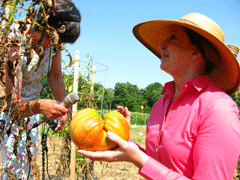
Author Amy Goldman, reporter Helen Palmer and a Sterling Old Norway heirloom tomato. (Photo: Joanna Rifkin)
From Brandywine to Purple Cherokee to Mortgage Lifter - a beautiful new book celebrates one of the most delicious tastes of summer, the heirloom tomato. Living on Earth’s Helen Palmer spends some time with Amy Goldman, author of “The Heirloom Tomato: From Garden to Table” on her farm in the Hudson Valley of New York.
Transcript
GELLERMAN: The French call it “pomme d’amour” - love apple. And the English? Well, the English call it:
PALMER: Tom-ah-to.
GELLERMAN: That’s Living on Earth’s Helen Palmer, and as you can hear. she says -
PALMER: Tom-ah-to.
GELLERMAN: And we say: tomato. Well, we’re not going to call the whole thing off, because it’s that time of year again, when the last of the summer’s vine ripe love apples, are the apple of every foody’s eye. Recently a gloriously illustrated book about tomatoes caught our eyes here at Living on Earth. It’s Amy Goldman’s new tome: “The Heirloom Tomato.”
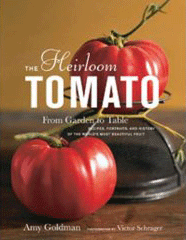
[SOUND OF CRICKETS]
GOLDMAN: Tomatoes and I go way back - I started growing them when I was seventeen years old - and ever since then I’ve had my hands in the soil.
PALMER: Amy Goldman grows peaches and blueberries, melons and squash. She keeps ducks and chickens, and, of course - she grows tomatoes. Today she wears a long sleeved shirt and broad brimmed straw hat against the brilliant late summer sun as she shows off her crops.
[SOUND OF WALKING ON STRAW]
GOLDMAN: We’re in the middle of Amy’s folly. This is an acre filled with 500 tomato plants, 250 different sorts, two of each.
PALMER: And unlike the tomato plants most of us buy from the supermarket - those four-packs of reliable hybrid varieties like Early Girl or Big Boy or Sweet 100 - Goldman grows heirloom tomatoes.
GOLDMAN: The term Heirloom - it means a tomato of value, capable of reproducing itself true to type, from seed that can be handed down to next generation.
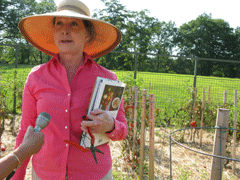
Author Amy Goldman in her tomato garden. (Photo: Joanna Rifkin)
GOLDMAN: The biggest mistake gardeners make is crowding them. I plant my tomatoes five feet apart in the rows and seven feet between rows. They need – first of all they need full sun. They need air circulation and that reduces the incidence of disease, and allows the plants enough room to grow and prosper.
PALMER: Still, even with optimal conditions and lots of space, some of Goldman’s tomato plants have shriveled brown leaves - just like mine.
GOLDMAN: This summer we’ve had a superabundance of water, and so the plants don’t like to have wet feet, and as a consequence, blight is on the march. We’re all in the same boat here and there’s not too much to be done. However, it’s interesting to see that some of these plants thriving and producing fruit by the bucket, so, we know that those are resistant to excess moisture.

Amy Goldman, reporter Helen Palmer and a Sterling Old Norway heirloom tomato. (Photo: Joanna Rifkin)
PALMER: Goldman heads down the row to a tomato plant with tentacle-like branches sprawling out over the straw.
GOLDMAN: In this most horrible of tomato years this plant is going gangbusters, I mean it’s moving across the garden at an alarming rate and in fact probably spreading out about eight to ten feet in diameter.
PALMER: This tomato’s leaves are bright green, and it’s laden with sprays of tiny currant-like fruits.
GOLDMAN: Alberto Shatters. It’s a very primitive plant. It shatters, it drops its fruit when the fruit is ripe. The tomato quality is superb, in fact it’s high in acid, high in sugar, very crunchy, and just wonderful. It’s probably, if not the smallest - one of the smallest tomatoes in the world, weighing in at about a gram. You know, you can’t even weigh it in ounces. It’s about a gram and the size of a garden pea.
PALMER: They taste good and you think they’re…?
GOLDMAN: Well, try it for yourself.
PALMER: I guess I’ll have to. Let’s see if I can find a ripe one.
GOLDMAN: Just give it a shake and they’ll fall off.
PALMER: These pea-sized tomatoes pack a powerful flavor punch - but that’s not their only value for Goldman.
GOLDMAN: Not only are they flavorful and historic and beautiful garden plants, but it’s been found that plants’ wild relatives contain genes that, bred into modern tomatoes can confer disease resistance and other fine traits.
PALMER: That’s one of the important lessons Goldman wants her heirloom tomato book to teach. She says the earliest wild tomatoes from South America’s coastal highlands were small ones like these Alberto Shatters - the plant was domesticated in Mexico and gradually bred and selected to create all the varieties we know today. Goldman points to a huge plant in the next row, bending with the weight of bunches of egg-shaped tomatoes.
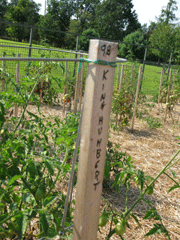
King Humbert. (Photo: Joanna Rifkin)
PALMER: Let’s go look at it.
[WALKING]
GOLDMAN: There’s Re Umberto genes in every one of the plum tomatoes we know today. This was named in honor of Umberto I, King of Italy about 1878.
PALMER: One thing I’m noticing about it as I look at it is, it seems to be suffering less from the blight and the browning leaves than the others, and it’s very very heavily cropping. There are lots and lots and lots of tomatoes on it.
GOLDMAN: This is the value of this variety, because it’s low input, generations of Italian peasant farmers have grown it because it doesn’t require staking, it doesn’t require watering or any attention whatsoever.
PALMER: Those generations of Italians – like peasant farmers across the globe – recognized the value of this crop, so saved some of the seeds to plant the next year. They passed them on to their children – and their grandchildren – that’s the paradigm Goldman wants the rest of us to follow. Under many of her plants lie abandoned tomatoes, apparently rotting.
GOLDMAN: I couldn’t possibly eat all of the varieties that I grow and I joke I’m running a private CSA for my friends and family.
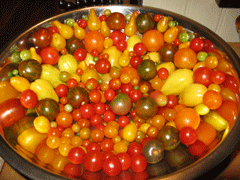
Tomatoes from Amy Goldman’s garden. (Photo: Joanna Rifkin)
PALMER: Goldman’s a board member of The Seed Savers Exchange, an Iowa based non-profit that’s gathered over 25,000 varieties of heirloom vegetables in the last thirty-three years.
GOLDMAN: The mission is to stop the extinction of our food crops. We have developed a network of people dedicated to collecting, conserving and sharing heirloom seeds and plants - while educating the general public about the virtues of genetic and cultural diversity.
PALMER: Goldman wants to spread this knowledge. She says one to two percent of heirloom varieties disappear every year as hybrids take over, and we might need that genetic diversity for our food crops in the future. Her book also traces the history of some 200 luscious tomatoes. It includes taste tests and recipes, and celebrates their evocative names.
GOLDMAN: There’s the Radiator Charlie’s Mortgage Lifter, there’s the Nebraska wedding tomato – you know, the heirloom tomato is the people’s tomato. It’s of, by and for the people. You know there’s a tomato called “My Owna” – because it’s my own.
PALMER: And there’s Black Prince, White Beauty, Silvery Fir Tree, Green Doctors, Plum Lemon, Purple Calabash, Sun and Snow. All shapes for all uses - cup-shaped ones perfect for stuffing, tiny cherries to pop like candy, mammoth meaty beefsteaks for sandwiches – and all sizes and all colors.
GOLDMAN: This tomato over here – is the yellow peach tomato.
PALMER: It’s not shiny.
GOLDMAN: It’s not at all shiny – in fact it’s fuzzy like a peach. The yellow peach tomato. This is strictly garden to table – this is a rare treat that can only be grown by the home gardener.
They’re so fragile, but so wonderful. And, I make a wonderful galette with the peach tomato and white peaches.
PALMER: So that’s a kind of pie?
GOLDMAN: It’s a kind of pie.
PALMER: Which goes to remind us that the chief joy of tomahtoes – or tomaytoes – however you pronounce them - is to eat them. And though we nibbled our way up and down the rows, it’s lunch-time.
[STARTING UP THE MULE]
PALMER: Goldman starts up the little garden cart she uses round the farm, to take us from the tomato field back to the farmhouse.
[BRAKING SOUNDS, BIRDS, CRICKETS]
PALMER: The smell of garlic and basil wafts out through the open kitchen door. Inside a dozen bronze casts of huge, perfect tomatoes and squash line the kitchen counter. A restaurant-size fridge and freezer hum and on the table are baskets of multicolored tomatoes.
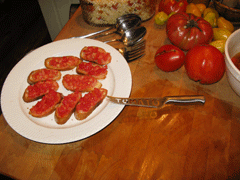
Spanish tomato bread. (Photo: Joanna Rifkin)
There’s nothing in the world like a homegrown tomato. And heirlooms – my 35 yrs of experience as a grower, plus considerable book learning - have taught me that heirloom tomatoes ripened on the vine in full sun are the most delicious tomatoes of all.
PALMER: And the tomatoes Goldman offered, and we ate, were indeed delicious. As another tomato season declines – as the nights get colder and the vines shrivel – I’m sad. But Goldman sent me home with a huge basket of assorted heirlooms – and I saved lots of the seeds for next year.
For Living on Earth, I’m Helen Palmer.
GELLERMAN: For loads of information about Amy Goldman’s book “The Heirloom Tomato” - and photos - and recipes! – go to our website loe.org.
[MUSIC: Heirloom Tomatoes: John Denver “Homegrown Tomatoes” from Higher Ground (Windsatr Records 2005)]
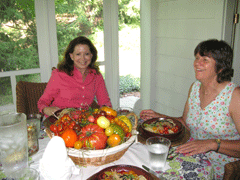
Amy Goldman serves Helen Palmer Spaghetti with Cherry Tomatoes and Toasted Crumbs
|
Yield: 10 portions The cherry tomato salad is the heart of this matter; a one-hour waiting period after assembly allows the salt, and the acid from the vinegar, to pull out the natural juices and flavor of the tomatoes. Toasted crumbs make a fine topping. I could eat this every day. Toasted Crumbs 1 loaf rustic bread Cherry Tomato Salad 1 pint sherry shallot vinaigrette (see recipe) 1. Preheat the oven to 350 degrees. 2. Remove crust from the loaf of bread. Cut bread into large dice. 3. Pulse in the food processor until pieces are medium sized. 4. In a large bowl, toss bread crumbs with olive oil, salt, and pepper. 5. Spread crumbs evenly on cookie sheets and bake, turning frequently until browned. Cool and reserve. 6. Slice the cherry and currant tomatoes in half. Combine with the sherry shallot vinaigrette one hour prior to serving. 7. Bring the water to a boil and add the salt. Cook the pasta until al dente, approximately 7 minutes. Drain. 8. Chiffonade the basils. 9. In a bowl, toss the pasta with the cherry tomato salad. 10. Plate the pasta, garnish with parmesan, basil, and toasted crumbs. Serve right away so crumbs remain crispy.
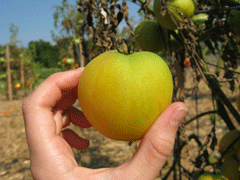 The yellow peach tomato before being baked into a galette. (Photo: Joanna Rifkin)
|





